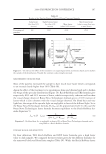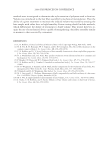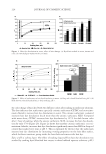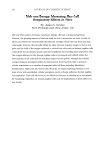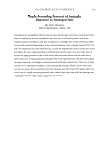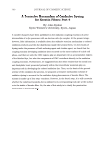2008 TRI/PRINCETON CONFERENCE 91 while others were of the punctual type produced by thermal stresses. Figure 5 shows, for instance, agglomeration of micro-cavities at the cuticle cell edges appearing after solvent immersion. These gaps, although, somewhat irregular in shape are similar to those shown in Figure 2. Figure 6 shows punctual cavities that appeared also after solvent immersion. These cavities have a striking similarity to those produced by thermal stresses. EFFECTS OF WATER PENETRATION INTO GAPS AND CAVITIES In most cases immersion of hair fi bers in water led to the closing of both types of defects namely, the extended gaps and the punctual cavities although, not all these defects were al- ways seen to close even after long periods of water immersion (see Figure 7a,b). In fact, it was observed that a large number of cavities, in particular, those associated to buckled cuticle cells of hair fi bers subjected to large cyclic extensional deformations (25%) were unaffected by water immersion. Since keratin fi bers can be considered as biopolymers that display viscoelas- tic or plastic behavior (9) depending on the strain level, it is expected that gaps and cavities will close when their associated deformations fall within the protein viscoelastic range (see Figure 7b). Water immersion will, thus, have the ability to accelerate the recovery process within this range as it plasticizes and relaxes the stressed proteins of the cuticle cells. Figure 5. (a,b) Micrographs (300×) of cavity agglomeration produced in hair fi bers after immersion of 3 min in IPA. The images were obtained by optical microscopy and show patterns of light interference due to the presence of cavities fi lled with air under the cuticle cell surface. Figure 5c is a schematic representation of cavities fi lled with air after extraction of exogenous lipids. Figure 6. Micrograph (600×) of punctual cavities (Φ ~ 1.0 μm) without bulge formation produced in hair fi bers after immersion in IPA for 3 min. The micrograph, taken by optical microscopy, shows the presence of colorful light interference dots produced by the presence of air cavities under the cuticle cell surface.
JOURNAL OF COSMETIC SCIENCE 92 Gaps and cavities are, thus, the result of harsh mechanical and thermal grooming stresses that deform the protein structure by excessive extension or contraction. In many cases these deformations may be accompanied, either, by a loss in the cross-linking density of the pro- tein structure or by cement breakage at the cuticle cell membrane complex. If the deforma- tions are within the range of viscoelastic reversibility, the cuticle cells will recover by water plasticization. However, if the damaging stresses are severe, the cuticle cells undergo creep- ing and plastic deformation and gaps and cavities are recovered by water immersion. It is interesting to note that, while buckled cuticle cells forming gaps were able to recover from their deformed state, their cementing didn’t recover once it was broken. This phe- nomenon could be confi rmed by the following simple experiment: First, hair fi bers with decemented and buckled cuticle cells were allowed to recover by water immersion. Sub- sequently, the hair fi bers were dried for 24 h at room temperature. Later, when the dried hair fi bers were re-immersed in water again the decemented cuticle cells reopened and buckled while in water (see Figure 8) this phenomenon was, in particular, stronger at alkaline pHs ranging between 9 and 11. Hair fi bers whose cuticle cells were not dece- mented didn’t display this behavior. These observations indicate that once the cuticle Figure 7. Micrographs (300×) of a hair fi ber before (a) and after (b) it was immersed in water for 3 min. Observe the disappearance of the light interference patterns in Figure 7b due to viscoelastic recovery of de- formations sustaining the cavities. The hair fi ber had previously been immersed in IPA for 3 min. Figure 8. Micrograph (250×) of a hair fi ber showing cuticle lifting while immersed in water at pH 10.0. The cuticle cells of this fi ber had been previously decemented by applying 10 cycles of 15% extension and retrac- tion. Subsequently, before immersion is alkaline water, the deformed cuticle cells were allowed to recover in water at neutral pH for 5 min. and the fi ber was allowed to dry at room temperature for 24 h.
Purchased for the exclusive use of nofirst nolast (unknown) From: SCC Media Library & Resource Center (library.scconline.org)














































































